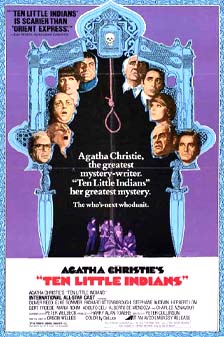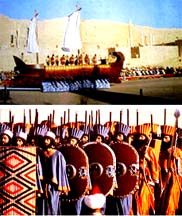“In Italy for thirty years under the Borgias they had warfare, terror, murder, bloodshed–they produced Michelangelo, Leonardo da Vinci and the Renaissance. In Switzerland they had brotherly love, five hundred years of democracy and peace, and what did they produce? The cuckoo clock!” – Harry Lime played by Orson Welles in Carol Reed's 'The Third Man'
To millions around the world, Orson Welles IS Citizen Kane. The only filmaker to have re-invented cinema both as a language and an artform with his very first film début ( he was only 25 years old ) . Charles Foster Kane's final words “Rosebud” were actually the freudian underlining theme on which the whole film's plot is constructed. “Rosebud” is supposed to have been a symbol of Kane's innocence, the reason that drew the great man to becoming who he was, a legend.
Kane's character was based on the press mogul and multi-billionaire William Randolph Hearst and “Xanadu”, Kane's mansion, was also based on the Hearst's residence (interestingly the real mansion was also used for the Roman settings of Stanley Kubrick's 1960 film “Spartacus” with Kirk Douglas).
Welles' inimitable voice is forever associated to the 1971 documentary film on the Persepolis celebrations marking twenty five centuries of persian kingship. The “King of the Silver Screen” was also to produce two other personal projects in the years that followed with the help of Iranian producers, one of which was also to become Orson Welles last and unfinished film.

Orson Welles built his legend by generating controversies: His successful 1938 Radio Show “War Of The Worlds“, followed by the critically acclaimed but Commercially disaster “Citizen Kane”. His short appearance in Carol Reed's “Third Man”, With Charlton Heston in the “Touch of Evil” another failed attempt to seduce Hollywood. Insert Welles at age 25 when he directed Kane.
Welles made a carreer by generating controversy. His very first “Coup de Maître” was his famous 1938 Radio adaptation of a Science fiction Comic Strip “War of the Worlds“ about Martians who after landing on earth destroyed the City.
On October 30, 1938, this live program caused mass hysteria all over America. People got scared, and the whole nation was totally paralysed for a few hours. This radio hit however propulsed Orson Welles as the new genius artist and opened doors to one of Hollywood's most prestigious film studios, the RKO.
Welles was to have the unpredecedant oppurtunity to have complete control over his very first film without the interference of any film censor. The 25 year old film novice is said to have learned in two hours what he needed to know about filmaking by watching John Fords Stagecoach.
The result was “Citizen Kane”, a commercial flop but an undeniable critical success that was to imprison Orson Welles' reputation among film producers in a Golden Cage of misunderstanding for the years to come. This did not stop the future film legend to make movies but it was always with a great deal of difficulty. Likewise his next film “The Magnificent Ambersons“ proved to be just as unsuccessful for film studios.
From then on Hollywood Studios were to close their doors on Welles who therefore tried to put up his ambitious projects with the help of European producers or anyone who could offer financial support. This explains the incredible number of Commercial Appearacnes of the great Orson in commercial films as a guest star such as in René Cléments “Is Paris Burning ? “, Carol Reeds espionnage “The Third Man” (for which he wrote his own short dialogue, as Harry Lime), Peter Collinson's “Ten Little Indians” or Mike Nichols “Catch- 22“ to name a few.

Agatha Christie Thriller )
A man of immense culture and energy, Welles' appetite for creation was not always easy to satisfy. He was a Painter, Magician, Journalist, Radio entertainer, and a Man of Theater, yet Welles was to impose himself as a major filmaker ( see filmography) in the History of Motion Pictures. He was also to use his screen presence and splendid voice for great adaptations of Shakespeare for Screen such as “Othello” or “Macbeth” which used little sophisticated material but remain perfect examples of artisitc creativity to this day.
Often defining himself as a “Man of the Rennaissance”, Welles was more pre-occupied by creating than anything else.The Common denominator in most Welles characters is certainly the fact that they are “Bigger than Life”, be it , Kings or Jesters, they all hide their weakness' behind an imposing and powerful presence, this is expressed through generosity by Falstaff , mediocre ambition by “Macbeth” or Kane, and Blind Jealousy as for “Othello”.
Curiously and similarily to the Renaissance Artists, always trying to make ends meet and eagerly in search of financial backing for future artistic projects.Welles was at the financial mercy of Art Patrons worldwide accepting or refusing to finance his projects, be it Jet Set Millionaires, South American dictators, Presidents, or Kings …

Imperial Iran's “Epic” response to Hollywood:
The Persian Empire narrated by Orson Wells in October 1971
It was therefore quite an omen for him to be approached by the Iranian Government's Ministry of Culture in order to narrate an upcoming documentary film on the Persepolis Ceremonies held in October 1971, by the Shah of Iran.
Welles was to participate to this project that could also open doors on eventual financial partners for his other ambitious projects. He was also to narrate an intimate documentary on the Persian Emperor in 1972 entitled directed by Walter Ellaby. The film was released again in 1980 as a retrospective on the recently toppled Shah.
This first collaboration however led Welles to undertake with the help of his Iranian Producers the filming of the two final and most ambitious film projects of his entire carreer “F for Fake” and “The Other Side of the Wind”. Welles did not live to see the latter completed…

(Left ) On the set of Welles Last film, “The Other Side of the Wind” which was never released with John Huston, Orson Welles and Peter Bogdanovich (who worked on the script). Right “F for FAKE” also co-produced by an Iranian Production
Synopsis: “F For Fake” (1973)
“Orson Welles has a ball examining the nature of what is real and what is fake in the funny, bizarre 'F For Fak'. Four people stand at the center of this documentary: Elmyr de Hory, who some believe forged more than a thousand masterpieces, many of which hang in some of the world's most famous museums; Clifford Irving, who is not only out to prove what a fake Elmyr is but also wrote a fake biography of Howard Hughes; Oja Kodar, who claims that Pablo Picasso painted 22 canvases of her that no one has ever seen; and Welles himself, who harks back to his days creating the havoc-causing 'The War Of The Worlds' for radio. But the true star of the film is the editing; from absurd stock footage to shots of Welles smirking into the camera from different locations to scenes with a monkey scurrying about, the film is vastly entertaining to watch. 'F For Fake' is an underrated, underappreciated work of comic genius about the nature of reality, celebrity, and art, by a master filmmaker showing a surprisingly wicked sense of humor.”
“F for Fake” (1973) (French title “Verité et Mensonges” ) starred Welles himself as well as Joseph Cotten, and Jean-Pierre Aumont and Orson's last companion Oja Kojar. A highly intellectual and ambitious film essay on the art of illusion. Orson Welles weaves a wry, often whimsical, documentary about the nature of art to bedazzle and fool us all. Equally captivating is Welles' own trickery and a glimpse behind his public facade.He also performs a bit of trickery on the audience, which is revealed at the end of the film. I won't give it away.
The film was projected for the first time in 1973 during “The International Film Festival of Tehran” at Roudaki Hall after a tribute to Orson Welles who recieved an honorary Golden Winged Ibex for his entire Carreer.
“The Other Side of the Wind” ( Never released)
This film which also happens to be Orson Welles last movie has had a strange fate. As suggested in a recent book published in French “Orson Welles cin�aste, une cam�ra visible” (Three volumes) by Iranian film critic Youssef Ishaghpour : Welles in the last years of his life desperately seeked financial support for what was to become his testimonial movie “The Other side of the Wind”.
Youssef Ishaghpour claimes (See Authors Notes) that Mr. Mehdi Boucherie involved in the movie business and producer became the major financial supporters of the legendary director's movie about a “famous Hollywood director”, starring John Huston, that was shot in stages beginning in the early '70s and apparently not completely finished at the time of Wells' death in 1985.
“The Other Side of the Wind” was the film that the director of “Citizen Kane” and “Touch of Evil” hoped would return him to the big leagues. Part of the film's legend is that it was reportedly seized after the Ayatollah took power in Iran in 1979.
However it would seem that some of the financial partners of the Time particularily Mehdi Boucherie still have hold of the original film copy. A Lawsuite has been opposing them for years to Welles' counterparts including director Peter Bogdanovitch and Personal Friend of the Legendary Director and some form of aggreement seems to have been reached. (See article “The Other Side of Orson Welles” ).
However to this day the great film master's “Final Cut” version is yet to be seen …
Recommended reading : This is Orson Welles by Peter Bogdanovitch
The incomplete footage of the Other Side of the Wind
Listen to excerpt of one of Orson Welles Radio show
DISCLAIMER:
Youssef Ishaghpour has recently published an important biography on Welles and his work he refers to Mr. Mehdi Boucherie's involvment in this project. A lawsuite is opposing Mr. Mehdi Boucherie who apparently is the owner of the film and his American counterparts.






